#metriorhynchid
Text
Paleozoo enclosure based on the Owadów locality in Poland.
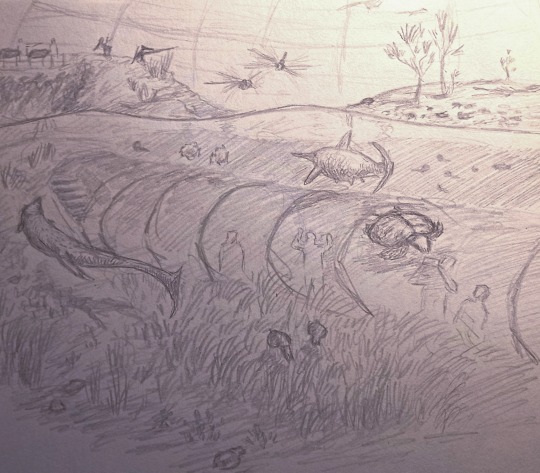
#biology#dinosaur#dinosaur art#dinosaurs#fossils#geology#mesozoic#palaeoart#palaeontology#paleoart#jurassic period#jurassic#solnhofen#poland#laggerstatte#paleozoo#sciart#pterosaur#ichthyosaur#metriorhynchid#crocodile#fish#zoo#prehistoric kingdom#jurassic park#dinosaur park#science
102 notes
·
View notes
Text
Speculative evolution/creature provided by my dream that I’m now kind of sad doesn’t actually exist: a corvid take on a penguin lifestyle that goes so far aquatic they basically turn into corvid orcas.
#this is probably because i was reading about metriorhynchids recently#and yes in the dream they were eating people#for some reason they specifically were eating kyoya so rip#we were in some deeply unsafe themepark that the corvidwhales werent even part of they just swam into it#and the staff was not helping me get people to safety at all i was so pissed#ecdysing
2 notes
·
View notes
Text
An international team of scientists, including researchers from Germany and the UK, have described a new species of ancient marine crocodile, Enalioetes schroederi. Enalioetes lived in the shallow seas that covered much of Germany during the Cretaceous Period, approximately 135 million years ago.
This ancient crocodile was a member of the family Metriorhynchidae, a remarkable group that evolved a dolphin-like body-plan. Metriorhynchids had smooth scaleless skin, flippers, and a tailfin. They fed on a variety of prey, including fast-moving animals like squids and fish, but some metriorhynchid species had large, serrated teeth suggesting they fed on other marine reptiles. Metriorhynchids are best known from the Jurassic Period, with their fossils becoming rarer in the Cretaceous. Enalioetes schroederi is known from a three-dimensional skull, making it the best-preserved metriorhynchid known from the Cretaceous.
Continue Reading.
66 notes
·
View notes
Text
I apologize for such a long delay. I couldn't find the motivation to keep posting here. But, as I promised in my last post, here are three more drawings made for last year's scientific conference. :)
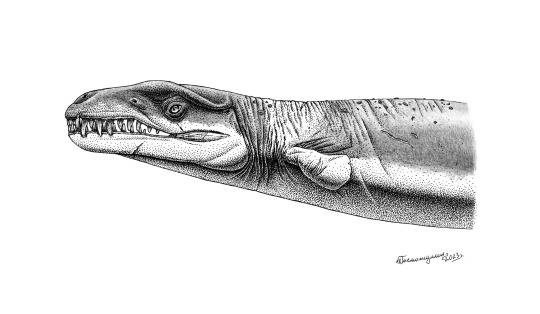
Front half of Dakosaurus andiniensis, massive metriorhynchid from Late Jurassic of Argentina. As with Cricosaurus, I based this reconstruction on metriorhynchid specimens with skin. Note the presence of speculative skin parasites, whose marks were founds in fossil skin. Also, there are salt glands in antorbital fenestra. This feature is based on this study: https://anatomypubs.onlinelibrary.wiley.com/doi/10.1002/ar.24678
BTW, some recons portray Dakosaurus with crocodile-like facial integument and some recons even have "lips"! I decided to diversify from these both options and did it with smooth streamlined skin.
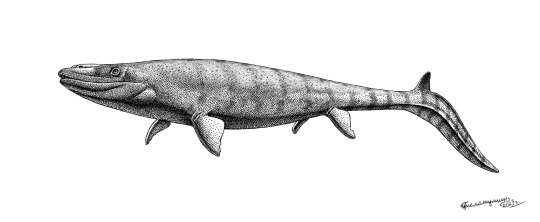
Prognathodon sp. reconstruction based on purportedly juvenile specimen with soft tissue outlines from Late Cretaceous of Jordan. This small individual was described in this paper: https://www.nature.com/articles/ncomms3423 Preserved skin impressions include silhouettes of the skin fringes of the flippers and the caudal fin. The caudal fin is quite small, but in adults it could be proportionally larger. This finding confirmed that mosasaurs converged with ichthyosaurs and metriorhynchids to develop a fish-like caudal fin.
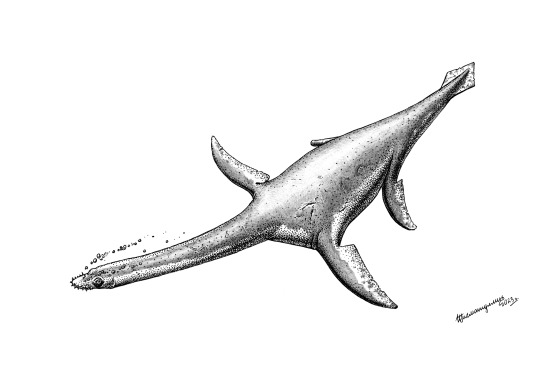
And finally, Seeleyosaurus guilelmiimperatoris (formerly species of Plesiosaurus), a microcleidid plesiosaur from Early Jurassic of Germany. Holotype of this species is almost complete specimens with some skin impressions including rhomboidal skin flap. Perhaps all plesiosaurs had caudal fins of one form or another. However, their orientation is controversial: many paleontologists are of the opinion that the fin was vertical, but others think it was horizontal.The arguments in favor of the second point of view are the rigidity of the chest, the flat and wide shape of the tail in the proximal part and the absence of bending in the distal part of the tail: https://www.researchgate.net/publication/339423536_Peculiarities_of_the_Structure_and_Locomotor_Function_of_the_Tail_in_Sauropterygia I decided to choose this version for reconstruction. Which of the scientists is closer to the truth, new findings will show.
All of these drawings were done with black gel ink pen and black colored pencil with small additions of white gouache.
#dakosaurus andiniensis#dakosaurus#metriorhynchidae#thalattosuchia#prognathodon#mosasaur#seeleyosaurus#plesiosaurus#plesiosaur#sauropterygia#marine reptile#paleoart
24 notes
·
View notes
Text
Torvoneustes jurensis
I did mention that new croc taxa were numerous this week. After covering both Triassic forms, here's the newest crocodyliform from the Jurassic. Torvoneustes jurensis, a large (4 meter) metriorhynchid.
Artwork by SDSO, figure from Girard et al. 2023


Now the genus Torvoneustes itself isn't a new one. The genus itself has been knocking around since 2010 whereas one species has been known since 1910. Fossils of this genus have previously been found in the UK, Czech Republic and even Mexico. This species tho is brand new tho, found in the Jura Mountains of Switzerland in 2008. The fossils date to the Kimmeridgian, the second to last stage of the Jurassic.
Like its relatives, Torvoneustes jurensis was an animal well adapted for life in the open ocean. The eyes faced sideways, the limbs were converted into flippers (with especially short arms), the tail had a fin more like that of a shark than the paddle of a crocodile. And it was smooth, lacking the osteoderm armor we so often associate with pseudosuchians. It reached a length of up to 4 meters, which puts it among the larger metriorhynchids alongside Suchodus (4.1), Dakosaurus andiniensis (4.3) and Torvoneustes carpenteri (4-4.7).
Artwork below by Dmitry Bogdanov

Being recovered as one of the most derived members of its genus, Torvoneustes jurensis is interesting as it allows to further observe the evolutionary trends undergone by this lineage. For example, the skull bones appear to have become increasingly smoother, possibly to be more hydrodynamic or because basking becomes less important. The oldest species also lacks the pseudoziphodont teeth seen in all others, but its possible that this was just lost in one form and retained by all others. There's also some straight up contradictions presented by T. jurensis relative to other species. For example, previously it was thought that species in the genus became increasingly durophagous, taking on harder shelled prey and thus developing less curved, more robust teeth. This does however not seem to be the case for this new species, which could have been more of a generalist. It also retains more teeth than other derived species of Torvoneustes, another trend seemingly debunked by this new find (tho toothcount was so far limited by available material, so this may change still if we find better fossils of the other species).

Overall its another really interesting find and while not a new genus, its still nice to see further exploration of the species diversity among crocodyliforms
#palaeoblr#prehistory#jurassic#croc#pseudosuchia#thalattosuchia#metriorhynchidae#geosaurinae#ocean croc#marine reptile#paleontology#paleontology news
57 notes
·
View notes
Text
Description and phylogenetic relationships of a new species of Torvoneustes (Crocodylomorpha, Thalattosuchia) from the Kimmeridgian of Switzerland
Published 19th July 2023
A new metriorhynchid from the Kimmeridgian of Porrentruyi Switzerland based on a relatively complete disarticulated skeleton, Torvoneustes jurensis.
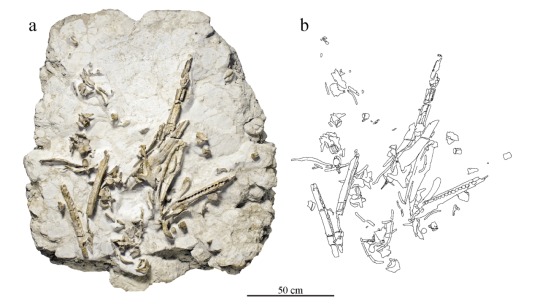
Torvoneustes jurensis holotype
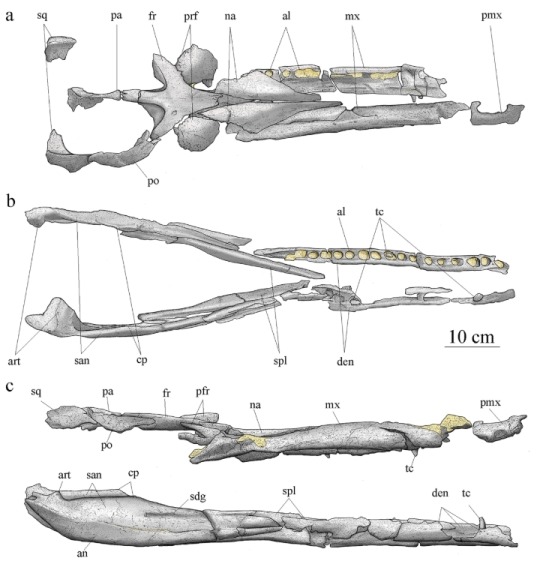
Artist illustration of jaw and mandible

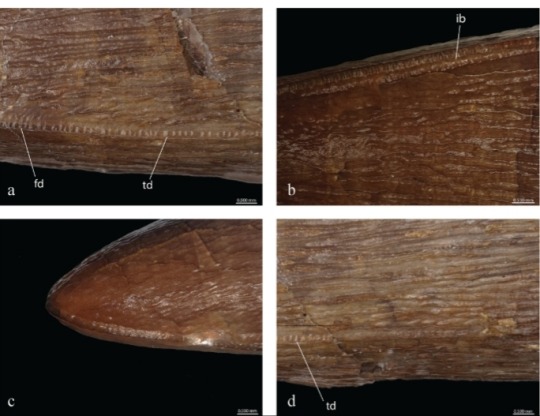
Torvoneustes jurensis teeth

Artist reconstruction of Torvoneustes jurensis, by SDSO.
Source:
9 notes
·
View notes
Text
Caecilians of Lemuria
Where in most landmasses squamates thrive, on Lemuria they are only represented by geckoes (which boast an impressive diversity of 60 known species), two snakes, a monitor lizard and a few oplurids. Many niches are taken by their sphenodont relatives, whose fortunes have favoured them on this island, but the majority of squamate niches are instead taken by caecilians.
Caecilians in Lemuria are represented by two clades: Chikilidae and Ichthyophiidae. Having a presence in mainland Asia – which is speculated to be a result of India colliding with Asia – chikilids thrived in former Maldivia and ichthyophiids in former Marama. The former, finding themselves with few squamatan competitors, wasted no time expanding into niches taken by squamates elsewhere, while the latter found themselves in an environment with few competing fishes.
Thus, when the two landmasses collided and formed Lemuria, neither competed with one another: chikilids took the land, while ichthyophiids took the water.

Phytophis fatamara or Palavify, a herbivorous chikilid demonstrating the long facial tentacles, large eyes and scale-derived spikes often present in non-subterranean species. It grazes slowly on the open pastures, eyes constantly watching and tentacles constantly feeling the texture and taste of vegetation. By Dave Garcia.
Represented in mainland Asia by only a single genus, here there are 70 known species and probably far more, occuring in all manner of environments from wetlands to montane meadows to even semi desert. Unlike snakes, caecilians cannot unhinge their jaws, but their flexible and robust skulls more than make up not just in terms of prey capture (many species are venomous like snakes too) but also in grazing: some chikilids are among the few herbivorous adult amphibians out there.
Some species took to life in the trees; while the eyes increased somewhat, it was the tentacles present on all caecilians that engorged the most, becoming full on analogous to a mammal’s vibrissae or a serpent’s tongue, allowing them to feel for prey branches away. Others took like to open spaces; some are burrowers, while others took the fish scales present within the caecilian skin to develop long and unique spikes, looking like massive catterpilars as they graze.
Due to the sheer diversity of this group – small species barely interact with humans, for instance – there is all manner of folklore regarding these impressive creatures, from symbols of longevity like snakes to garden pests like snails. Many are part of Lemurian cuisine, and indeed many species are threatened by overhunting as well as habitat loss, pollution and fungi that target amphibians.

Pisciserpens sammangali or Pitava, demonstrating the fusiform fish-like body of the more aquatic members of this group. It forms large schools that migrate between the Great Lakes and the Sammangal, and is often called the “Lemurian sardine”. By Dave Garcia.
Also Lemuria has fishes, they’re most represented by a few families shared with Madagascar. The dominant force in Lemurian freshwater habitats are ichthyophiid caecilians. Some are still semi-aquatic terrestrial burrowers in wetlands and tropical rainforests, but several clades have taken to the water, developing a caudal fin (similar to that of ichthyosaurs, mosasaurs and metriorhynchids) and an oval, fish-like body shape with a dorsal and anal fin (they do not have fins/flippers, like fish-like molluscs, and do just fine without them). Like most amphibians they breathe through their skin – the dorsal and anal fins partcularly well suited for this due to the increased surface area – but the more metabolically active species regularly surface for air. Unlike aquatic salamanders, they lose the larval gills for hydrodynamic efficiency.
The vast majority of the aquatic species occurs in the Great Lakes region, where 80 species are known, occupying all manner of niches from sardine like filter-feeders to durophagists feeding on hard clams and snails to macropredators competing with the local crocodiles. At least 40 species migrate to the Sammangal during the monsoon season, taking advantage of the sunken forest to graze on the underwater saplings or adult leaves or hunt the myriad of prey availiable.
2 notes
·
View notes
Note
How it's made: potato chips
all good on suggestions now duck i just watched a video on metriorhynchids that was on my recommended instead of listedning to you on accident
1 note
·
View note
Text

Archovember Day 24: Cricosaurus suevicus
Last year I drew Dakosaurus, and now it’s time for its skinny cousin Cricosaurus to take the spotlight.
Cricosaurus is a genus of long-snouted Metriorhynchid crocodyliform fully adapted to marine life. Like most other Metriorhynchids, it had paddle-like feet, a tail fluke, and smooth skin. Cricosaurus adults and juveniles both had well-developed salt glands, which allowed them to drink salt water and eat seafood without dehydrating. It also seemed to have a large pelvic opening which would have allowed it to give live birth.
Cricosaurus suevicus shared its territory with a variety of other marine crocodylomorphs in the Late Jurassic ocean which would one day be Germany. It is suspected that this was possible due to niche partitioning: larger, short-snouted metriorhynchids like Dakosaurus and Geosaurus would have been the apex predators, while smaller, long-snouted species like Rhacheosaurus and Cricosaurus, as well as the teleosaurid Steneosaurus, would have preferred different types of fish. Cricosaurus suevicus was about 6 feet long.
There were at least 11 species of Cricosaurus, but I chose Cricosaurus suevicus because I liked the pose of its fossil. 😅
#my art#Cricosaurus suevicus#Cricosaurus#Metriorhynchids#crocodylomorphs#pseudosuchians#Archosaurs#archosauromorphs#Archovember#Archovember 2021#Draw Dinovember#Draw Dinovember 2021#Dinovember#Dinovember 2021#SaritaDrawsPalaeo
162 notes
·
View notes
Photo



It's been a while since I last showed off some of these, but here's some more commission work I've done for PBS Eons:
The metriorhynchid marine crocodilians Aggiosaurus and Cricosaurus, from "When Crocs Thrived in the Seas"
https://www.youtube.com/watch?v=vgqs_9BBX10
And… what's this?

A familiar Scutellosaurus makes an appearance in a recently-published children's dinosaur book!
———
Nix Illustration | Tumblr | Twitter | Patreon
#science illustration#paleontology#paleoart#palaeoblr#pbs eons#aggiosaurus#cricosaurus#metriorhynchidae#thalattosuchia#crocodylomorpha#crocodilian#pseudosuchia#stem-croc#art#scutellosaurus#published artwork
330 notes
·
View notes
Note
What do you think of Herrera et. al's 2015 paper on possible Metriorhynchid oviviparity? :)
I think the logic is pretty sound! Can't go on land, therefore can't lay eggs, and the sacral region of these animals is kinda weird in a probably-gives-live-birth way! It's a cool paper, really like it!
Here's the paper if other people want to read it! https://www.cambridge.org/core/journals/earth-and-environmental-science-transactions-of-royal-society-of-edinburgh/article/morphology-of-the-sacral-region-and-reproductive-strategies-of-metriorhynchidae-a-counterinductive-approach/AE3A4183C5925CFE4F6F3108B3B2C147
Also as this is my dragon blog I'll mention that my sea dragons have similar logic and also have live births instead of laying eggs - not certain my dragons will look like metriorhynchoids because I'm still trying to match myths to my dragon designs, but due to my line of work I'll be borrowing bits of thalattosuchian science to describe them :}
4 notes
·
View notes
Note
How did the Metriorhynchid Crocodyliformes reproduce? Being fully aquatic, they couldn't have been capable of hauling themselves on land to lay eggs? Is it more likely that (like a majority of the other marine reptiles from the Mesozoic), that they gave birth to live young?
See this previous ask. Since then, a conference abstract (Spindler, 2019) has surfaced reporting an undescribed metriorhynchid specimen that preserves evidence of live birth, so perhaps we’ll soon get a definitive answer to this...
3 notes
·
View notes
Video
youtube
Video by PBS Eons: When Crocs Thrived in the Seas:
While dinosaurs were dominating the land, the metriorhynchids were thriving in the seas. But taking that plunge wasn’t easy because it takes a very special set of traits to fully dedicate yourself to life at sea.
84 notes
·
View notes
Text
In the spring of last year, I made several color reconstructions of marine reptiles for a thesis and presentation (it was about the reconstruction of marine reptiles) for a conference that was held in Ulyanovsk in September. The drawings were done in ballpoint pen (lineart) and Paint Tool Sai 2.0 (shadows and colors).

The first is reconstruction of Mixosaurus cornalianus, a widespread small Triassic ichthyosaur. I had already drawn a Mixosaurus in water earlier and even wanted to use it in the article, but later changed my mind, deciding that lateral reconstruction would better convey the appearance of soft tissues. This earlier drawing can bee seen here:

Both pieces are based on the fin impressions described in 2020 from a specimen found in the Middle Triassic rocks of the Bezano formation, Italy (www.researchgate.net/publicati…). This specimen has preserved the tissues of the dorsal and caudal fins. Both prints have thin collagen filaments, and at the base of the caudal fin, it was possible to detect the remains of smooth, scaleless skin. The fins have a triangular shape, and the dorsal one is associated with 15-23 trunk vertebrae. In other words, its position turned out to be more
forward then in reconstructions done before his paper.

The second is lateral reconstruction of the metriorhynchid Cricosaurus albersdoerferi, belonging to a widespread genus that inhabited the shallow seas of future Europe, Central America and Argentina. It was not a particularly large animal, reaching from 2 to 3.2 meters in length. Like the first reconstruction of a Cricosaurus, which I performed in the spring, this drawing is based on a specimen that preserved a large volume of soft tissue on the tail (upload.wikimedia.org/wikipedia…). Also shown here is the salt gland in the antorbital fenestra, the presence of which was previously indicated in Cricosaurus araucanensis and Dakosaurus andiniensis. The spring work with C. albersdoerferi can be seen below:
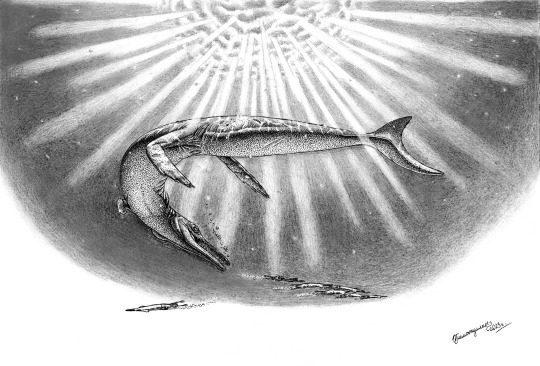

Plesiosaurs are mentioned too. This is reconstruction of the polycotylid Mauriciosaurus fernandezi from the Late Cretaceous of Mexico. A complete reptile skeleton preserved in fine-grained rocks was described by a team of paleontologists in 2017: www.researchgate.net/publicati… There are five types of soft tissue imprints around the bones. Among them are dark material, probably left from the walls of the peritoneum, dark gray traces of blubber and impressions of possible small scales. The impressions show that the animal's belly was covered with rectangular scales, which were mixed with inclusions of small fragments closer to the limbs. The scales of the living reptile were almost indistinguishable, so that the skin looked smooth. This beautifully preserved specimen showed that plesiosaurs had much more soft tissue than previously thought. The tail was especially fleshy. Fat deposits created a smooth, streamlined shape, ideal for an agile swimmer.
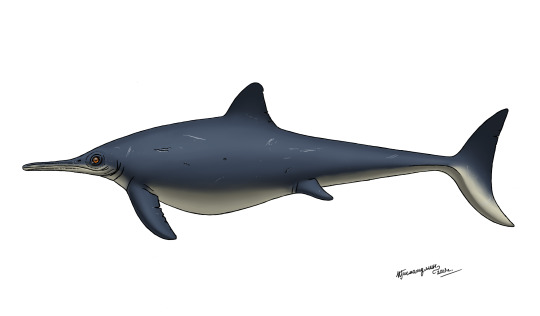
The last thesis drawing is this reconstruction of the famous Early Jurassic ichthyosaur Stenopterygius quadriscissus. Many of its skeletons of amazing preservation were found in the fine-grained limestones of Holzmaden, Germany. Some of them were discovered back in the 19th century, which made it possible to quickly correct previous ideas about ichthyosaurs. The Stenopterygius specimens retained soft tissue prints in the form of a bacterial film, which made it clear that they were fish-like creatures with a dorsal fin and a crescent tail. They re still attract the attention of researchers. In 2018, the skin structure of one partial specimen was studied: www.researchgate.net/publicati… A fossilized blubber was described, similar in microstructure to that of marine mammals and leatherback turtles. This led to the conclusion that ichthyosaurs were reptiles with a high metabolism, which required fat insulation. Blubber allowed ichthyosaurs to travel across the oceans, swimming even into the cold polar waters. In addition, this Stenopterygius had pigment cells - melanophores. They were absent on the ventral side, which means that the Stenopterygius had a dark back and a light belly. This countershading coloring is typical of today's marine vertebrates and serves as a camouflage.
I did also three works in fully traditional style, with pens and pencils, but I'll show them in the separate post. :)
#mixosaurus#stenopterygius#ichthyosaurs#cricosaurus#metriorhynchidae#mauriciosaurus#polycotylidae#plesiosaur#mesozoic marine reptiles#paleoart
31 notes
·
View notes
Text
Triassic Double Feature
Just weeks ago I remissed the lack of new croc taxa, seems I spoke to soon because they are being pumped out like crazy right now.
For simplicity, I will cover two of the recent sorta-crocs together as neither are super extensive and they match in overall time.
These two new genera are the aetosaur Kryphioparma and the phytosaur Jupijkam. Pictured below the fossils of both with reconstructions of close relatives (art by Brian Engh and Gabriel Ugueto).


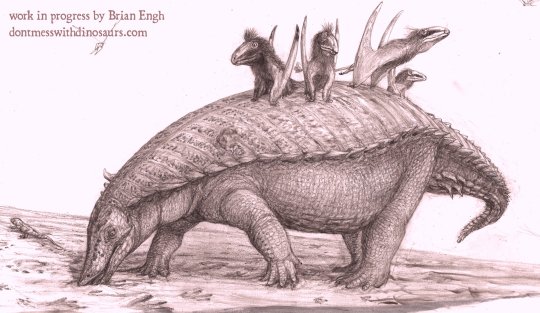

I'll start with Kryphioparma, which I wager is the less interesting of the two. Kryphioparma was an aetosaur, which are effectively early pseudosuchians that evolved a body type very similar to what nodosaurs did later. Heavily armored, sometimes with prominent spikes and herbivorous.
Kryphioparma is only known from four isolated and incomplete osteoderms, and though these are actually diagnostic and highly distinct, it does mean there's not super much to say. Hell, the scientific name literally means "mysterious shield" in reference to how little we know.
Regardless, scientists did determine two things.
1) It's a typothoracine aetosaur, narrowing down its placement to one of the two main branches. This means its closer related to Typothorax (with its armored cloaca) than to Desmatosuchus (with its shoulder spikes).
2) The second thing we know is that it wasn't alone. No, the localities that yielded its bones (Placerias Quarry and Thunderstorm Ridge) actually preserve a highly diverse aetosaur fauna, including Calypsosuchus, Tecovasuchus and two species of Desmatosuchus. All images by Jeff Martz.


Now the arguably more exciting find is that of Jupijkam, a type of phytosaur, which are archosaurs superficially resembling today's crocodiles. Now when I grew up, phytosaurs used to be considered to be entirely unrelated to crocs, being a type of archosaur believed to have diverged prior to the bird-croc split. However, it would appear that recent studies suggest that they could actually be true croc-line archosaurs, potentially being the earliest diverging group of Pseudosuchian.
Jupijkam is from the Rhaetian-Norian Blomidon Formation of Novia Scotia, Canada. This not only makes it one of the youngest, but also one of the northern-most known phytosaurs to date. It's scientific name, Jupijkam, is actually derived from the name given by the local Mi’kmaq people to their version of the horned serpent.
How Jupijkam is related to other phytosaurs is a bit wonky. Now generally, its recovered as a mystriosuchine, which isn't exactly a surprise given that most phytosaurs fall into this category. It's placement however shifts ever so slightly depending on the precise methods and characters used. 2/4 times it was found to be most closely related to Rutiodon (the phytosaur shown at the very start), once alongside the Indian Volcanosuchus and once to its exclusion. One tree simply results in a big polytomy which isn't really helpful, and one time it was found as a much more derived form related to Mystriosuchus. Whatever the case, additional finds both of other phytosaurs and Jupijkam specifically might clarify this in the future. Currently however, it seems that this form is not related to all the other American species of its time, suggesting it held out till the late Triassic independently. Which is pretty neat.
Below you can see a comparisson between Jupijkam and some other slender-snouted phytosaurs, courtesy of Brownstein 2023.
A is Jupijkam, B is Rutiodon and C is Machaeroprosopus

Really that wraps things up already, two new genera, both Triassic, both (potentially) early Pseudosuchians. A little bit out of my usual focus but very interesting none the less. Definitely gotta make another post soon since they just dropped yet another new one (a metriorhynchid), but I gotta read that paper first.
Speaking of which
A new aetosaur (Archosauria: Pseudosuchia) from the upper Blue Mesa Member (Adamanian: Early–Mid Norian) of the Late Triassic Chinle Formation, northern Arizona, USA, and a review of the paratypothoracin Tecovasuchus across the southwestern USA (escholarship.org)
A late-surviving phytosaur from the northern Atlantic rift reveals climate constraints on Triassic reptile biogeography | BMC Ecology and Evolution | Full Text (biomedcentral.com)
plus the respective Wikipedia pages
Kryphioparma - Wikipedia
Jupijkam - Wikipedia
#pseudosuchia#phytosaur#aetosaur#croc#palaeoblr#paleontology#prehistory#triassic#chinle formation#Kryphioparma#Jupijkam#long post#science#reptiles
40 notes
·
View notes
Text
Ancient crocodiles' family tree reveals unexpected twists and turns
https://sciencespies.com/nature/ancient-crocodiles-family-tree-reveals-unexpected-twists-and-turns/
Ancient crocodiles' family tree reveals unexpected twists and turns

Scientists probing a prehistoric crocodile group’s shadowy past have discovered a timeless truth — pore over anyone’s family tree long enough, and something surprising will emerge.
Despite 300 years of research, and a recent renaissance in the study of their biological make-up, the mysterious, marauding teleosauroids have remained enduringly elusive.
Scientific understanding of this distant cousin of present day long snouted gharials has been hampered by a poor grasp of their evolutionary journey — until now.
Researchers from the University of Edinburgh have identified one previously unknown species of teleosauroid and seven of its close relatives — part of a group that dominated Jurassic coastlines 190 to 120 million years ago.
Their analysis offers tantalising glimpses of how teleosauroids adapted to the momentous changes that occurred during the Jurassic period, as the earth’s seas experienced many changes in temperature.
“Our study just scratches the surface of teleosauroid evolution,” says study lead Dr Michela M. Johnson, of the University’s School of GeoSciences. “But the findings are remarkable, raising interesting questions about their behaviour and adaptability.
advertisement
“These creatures represented some of the most successful prehistoric crocodylomorphs during the Jurassic period and there is so much more to learn about them.”
The study reveals that not all teleosauroids were engaged in cut and thrust lifestyles, snapping at other reptiles and fish from the seas and swamps near the coast.
Instead, they were a complex, diverse group that were able to exploit different habitats and seek out a variety of food sources. Their physical make-up is also more diverse than was previously understood, the scientists say.
Previous research had provided insights into the origins and evolution of this fossilised croc’s whale-like relatives metriorhynchids, but less was known about teleosauroids.
To address this, the expert team of palaeontologists examined more than 500 fossils from more than 25 institutions around the world.
advertisement
Cutting edge computer software enabled the team to glean swathes of revealing data regarding their anatomical similarities and differences, by examining the entire skeleton, teeth and bony armor, which indicated whether species were closely related or not.
This information enabled the team to create an up-to-date family tree of the teleosauroids group from which emerged two new large groups, whose anatomy, abundance, habitat, geography and feeding styles differ from one another significantly.
The first group, teleosaurids, were more flexible in terms of their habitat and feeding. The second group known as machimosaurids — which included the fearsome turtle crushers, Lemmysuchus and Machimosaurus — were more abundant and widespread.
Names given by the team to seven newly described fossils, found in both teleosaurids and machimosaurids, reflect a curious range of anatomical features — among them Proexochokefalos, meaning ‘large head with big tuberosities’ and Plagiophthalmosuchus, the ‘side-eyed crocodile’.
There are even hints of their diverse behavioural characteristics and unique locations — Charitomenosuchus, meaning ‘graceful crocodile’ and Andrianavoay, the ‘noble crocodile’ from Madagascar.
Researchers have named the newly discovered species, Indosinosuchus kalasinensis, after the Kalasin Province in Thailand, where the fossil — now housed in Maha Sarakham University — was found.
The recognition of I. kalasinensis shows that at least two species were living in similar freshwater habitats during the Late Jurassic — an impressive feat as teleosauroids, with the exception of Machimosaurus, were becoming rare during this time.
Dr Steve Brusatte, Reader in Vertebrate Palaentology, at the School of Geosciences, University of Edinburgh, said: “The same way family trees of our own ancestors and cousins tell us about our history, this huge new family tree of teleosauroids clarifies their evolution. They were some of the most diverse and important animals in the Jurassic oceans, and would have been familiar sights along the coastlines for tens of millions of years.”
The study, published in the scientific journal PeerJ, was funded by the Natural Sciences and Engineering Council of Canada, SYNTHESYS Project and Leverhulme Trust Research. The Palaeontological Association and Paleontological Society provided travel grants.
#Nature
0 notes